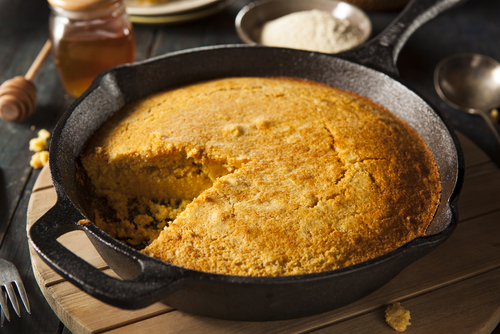
Source: Shutterstock
Have you ever looked at a slice of cornbread and thought to yourself, “hmm…segregation?”
No? Well, maybe you should.
Yeah, that’s right. Today we are talking about cornbread. And we’re also talking about race and class…
Like, did you know that there’s a small but meaningful difference in the way White people have traditionally made the classic soul food side dish and how we do it?
I didn’t either until I read this fascinating article in the Charlotte Observer yesterday entitled Why does sugar in cornbread divide races in the South?
As the title suggests, the difference between White people’s cornbread and our cornbread is that ours is much sweeter. Whereas, White people’s cornbread tastes like oppression.
I kid White people. But not about oppression.
Anyway…
According to writer Kathleen Purvis, who interviewed ground breaking Soul Food and Kosher historian Michael Twitty:
“In the beginning – and for Twitty, that goes back further than Emancipation – no breads made with cornmeal were sweet, no matter who was making them.
What we call cornbread today, puffy and leavened with egg, was corn pone. It originated with British colonists who adapted their baking to meal ground from white corn. But it wasn’t sweet.
Most people in the South, from white farmers to slaves, made multiple forms of cornmeal breads. Baked corn pones, skillet-baked Johnny cakes, ash cakes and hoe cakes cooked on hoe blades or griddles – “hoe” was an 18th century word for a griddle. Whatever they made, they kept a syrup bottle on the table, usually cane syrup or sorghum molasses, to pour on it.
“Why would you put sugar in something? It was a valuable commodity,” he says. “They didn’t need to put sugar in it, they used molasses on everything. That was the poor man’s condiment. Quick energy, quick carbohydrate, and a source of iron in the diet.”
So, how did sugar end up in Black folks’ cornbread?
Was our new preference for sweet bread a matter of personal taste?
Or was it all part of the White man’s master plan to give us all “the suga?”
As Purvis writes, the answers have more to do with industrialization. More specifically:
“Until early in the 20th century, Southern cornmeal was made with sweeter white corn and it was water-ground.
When industrial milling came along, that changed. The steel-roller mills used yellow corn that was harvested before it was ripe, so it had less sugar. They eliminated the germ so it kept longer, but it had less corn flavor. And they ground it finer. You had to add a little flour to help it rise and sugar to add flavor.
Yellow cornmeal was cheap, though. So black cooks who had little money may have changed their cornbread to match the cornmeal they could afford. Toni Tipton Martin’s new book, “The Jemima Code,” on the history of African-American cookbooks, shows that in the 19th century, books by Malinda Russell and Abby Fisher showed no sugar in the cornbread recipes. By 1912, in “The Kentucky Cookbook” by Mrs. W.T. Hayes, the cornbread called for 1 tablespoon sugar.
By 1936, she says, “The Eliza Cookbook,” by the Negro Culinary Arts Club, called for 1/2 cup sugar, 1/2 cup cornmeal and 1 cup flour – a recipe similar to today’s cornbread mixes like Jiffy. Martin thinks black cooks were influenced by those.”
As Purvis further acknowledges, contemporary palettes have both White and Black folks crossing over the cornbread line however for many White Southerners, the distinction runs a bit more personal.
More specifically:
“Ask many white Southerners about sweet cornbread and they become apoplectic: “That’s not cornbread, that’s cake.”
Actually, the cake-not-cornbread line may have originated with cookbook author Ronni Lundy. A Louisville native who now lives in Burnsville, she has a new book on mountain cooking, “Victuals: An Appalachian Journey With Recipes,” coming out next fall.
In a story in Esquire in the 1980s, she wrote this: “If God had meant cornbread to have sugar, he would have made it cake.” Over the years, though, she has learned that the sugar question can be divisive.
At a literary dinner in the 1990s, a black colleague told her, “ ‘Your cornbread is rich people’s cornbread.’ She was talking about yellow meal vs. white meal.” Lundy’s working-class white family in Kentucky grew white corn and always preferred white cornmeal, which didn’t need sugar and had the taste they expected.
The issue resonates strongly for her today as personal identity.
“For me, we don’t put sugar or flour in our cornbread in the mountain South because those were things we’d have to buy, or we’d have to be beholdened to someone for. Your daily bread was things you could grow yourself. When I taste the bread of my mother and forebears, it resonates for me culturally as an act of independence. Corn is an individual’s ability to feed him or herself.”
Not to put words in another person’s mouth, but it sounds to me that the resistance to claim sweet cornbread as authentic cornbread – as a matter of personal identity – might also have something to do with poor Southern Whites need to maintain some sort of cultural leverage over other folks (ahem…Black folks) whose independence was a bit more complicated.
But that’s none of my Jiffy mix…
Nevertheless, I don’t know about the rest of y’all, but I certainly feel a wee bit smarter having learned all of that. Coincidentally, I am also craving a plate of fried chicken, collard greens and of course a big ol’ healthy piece of Black America’s cornbread.
Who got me on a plate?









